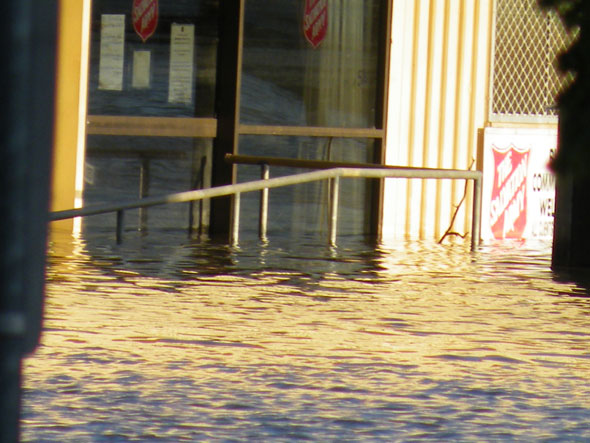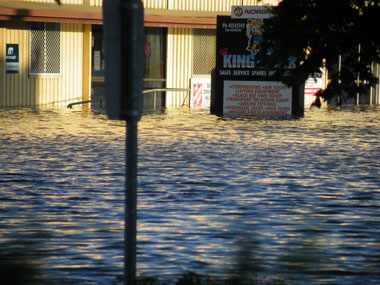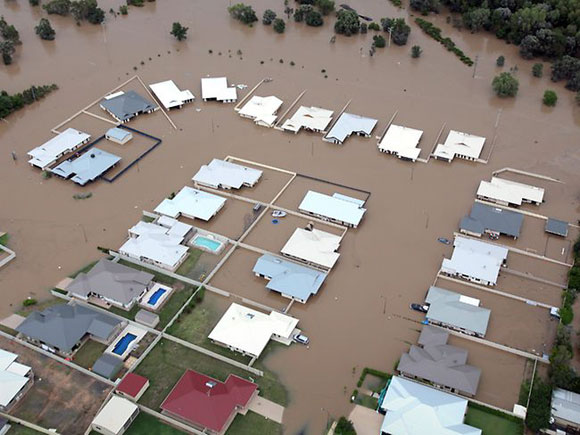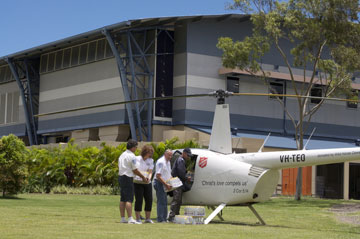
An "unprecedented" flood crisis in central and south-east Queensland has meant Salvation Army emergency services personnel from the Australia Eastern Territory have been working around the clock for a number of days in their relief effort to help tens of thousands of impacted people. Expectations are that the worst is yet to come for many areas.
Dozens of cities and towns have been affected by the floods—the deluge continuing largely unabated since Christmas Eve—with some areas recording more than four times their average monthly rainfall for December.
A number of rivers have burst their banks, inundating town centres and leaving many smaller communities completely cut off. The floods already encompass an area larger than the combined size of France and Germany.
"The level of rainfall has been phenomenal," said Central and North Queensland Divisional Commander Major Rodney Walters who has been helping to coordinate The Salvation Army's relief effort from Divisional Headquarters in Rockhampton where residents are bracing for the worst floods in 20 years.
"It's been raining virtually non-stop for days on end and with many rivers still to reach their predicted peak the worst is yet to come in terms of flooding," he added.
More than 200,000 properties across Queensland are still without power—most of them in the Bundaberg region—with thousands of people being forced to evacuate their homes. It is expected that it will be at least several days before they will be allowed to return to their homes.
Other areas hard hit include Emerald—where up to 80 percent of the city is inundated—and the communities of Gin Gin, Dalby, Theodore and Chinchilla.
Eight areas across southern and central Queensland are the subject of government disaster declarations with Queensland Premier Anna Bligh describing the floods as "an unprecedented situation in Queensland."
 In Rockhampton, The Salvation Army has been involved in feeding more than 1,200 people at three evacuation centres in the city while also providing meals for dozens of volunteer and support staff.
In Rockhampton, The Salvation Army has been involved in feeding more than 1,200 people at three evacuation centres in the city while also providing meals for dozens of volunteer and support staff.
Further west at Emerald—where the Nogoa River is expected to peak at 16.2 metres—and south at Bundaberg, more than 1,400 people are being provided with meals by Salvation Army emergency services personnel.
The Salvation Army is also feeding more than 350 travellers at Gin Gin who have become stranded after all major roads in the area were cut off by floodwaters. Rail services have also been affected.
The emergency relief effort is being assisted by The Salvation Army Flying Padre helicopter service through the transportation of supplies to stricken communities over the vast area impacted by the flooding. The newly commissioned helicopter is also being used to rescue people trapped by the floods in dangerous situations.
"The Salvation Army emergency services teams are providing care and feeding programmes to flood-evacuated people at a number of designated evacuation centres," said Central and North Queensland Divisional Communications and Public Relations Secretary Captain Megan Gallagher.
"These emergency teams are mostly made up of Salvation Army volunteers who are also in some circumstances, themselves the victims of the floods."
At Warwick, in south-east Queensland, The Salvation Army is involved in feeding more than 800 motorists who have become stranded in the city with all major roads in the area cut by floodwaters.
With river levels in many areas not forecast to peak until early next week, The Salvation Army is bracing for the relief effort to continue well into this new year.
God Works Amidst the Flood
by Bill Simpson

It was mid-evening on January 4 as Majors Don and Eva Hill arrived home from another energy-draining day of feeding physical and spiritual food to flood-ravaged residents of a small Queensland town that had become an inland island.
The retired Salvation Army officers were exhausted. They had barely had a break since floodwaters entered Emerald (17,000 population) in central-west Queensland just after Christmas Day.
Salvation Army reinforcements had arrived from Blackwater—flown in by helicopter because it was the only way to reach the town located on the Nogoa River, which bisects Emerald's main street. Other Salvation Army support was coming from Cairns, Canberra and Brisbane. The Salvation Army's Flying Padre helicopter from Mt. Isa was also involved.

Almost every day for two weeks, Don and Eva—relieving officers at Emerald Corps—served breakfast, lunch and dinner to hundreds of residents evacuated from their homes engulfed by the floodwaters.
For most of late December and early January, Emerald was the worst affected town of a flood that turned a part of Queensland—the size of France and Germany into a sea.
So damaging were the floods that Emerald Mayor Peter Maguire estimated it would take up to two years for Emerald to recover. Emotionally, many residents will take much longer. Everything they owned has gone.
Although, as flying padres for nine years shortly before retirement, they had been through floods and famine many times, this was the worst.
"It breaks your heart," Major Don says after spending another night at an evacuation centre.
Don Hill is an experienced officer. He has learned that in a crisis, there is a job to be done. It's apparent from our conversation that he doesn't dwell for long on a disaster. Nor does he allow the emotion to affect the job he has been given.
His corps was on the least-affected eastern side of the main street bridge, which, by December 30, was under water. With the local council in charge, an evacuation centre was quickly set up to accommodate evacuees.
He gathered his corps membership—just a handful of devoted Salvationists. They got a feeding programme in place. Some crossed to the other side of town to assist at other evacuation centres.
From early morning to late night, they worked to help locals dispossessed of home and possessions to cope through the worst flood in Emerald's history.
Don's evacuation centre was handling up to 160 residents at any one time. Across town, 300 people were cramming into other centres.
At first, food was hard to find. Local residents had been aware since early December that devastating floods were on the way. Shops were selling out of food quickly as locals prepared for the water to enter their town.
There were times, Don confesses, when he wasn't sure if there would be food for the next day. But it just kept turning up—day after day.
"I don't know where it was coming from," he said. "But it came. Our evacuation centre was at the local agricultural college. We were given the support of the college's two cooks and kitchen. One day when a truck pulled up with a load of food, one of the cooks who is not a professing Christian said: 'God must be real.'
"I must say that I thanked God with all my heart at that moment."
The night we talked, Emerald's main street bridge began to re-emerge from the muddy waters. It was a hopeful sign.
"We're tired; yes. We wish it would all just go away; yes," Don said. "But we have been sent here [Emerald] as Salvation Army officers. We have a job to do. And with God's help, we will continue to do it until it's time to hand over to somebody else."









Comment
On Thursday, January 6, 2011, abi nzimba said:
Leave a Comment